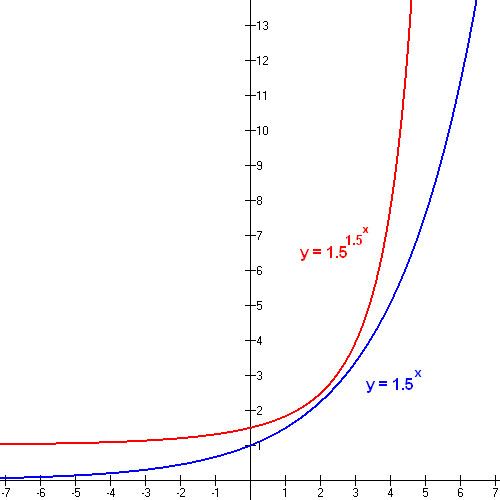 | ||
A double exponential function is a constant raised to the power of an exponential function. The general formula is
Contents
Factorials grow more quickly than exponential functions, but much more slowly than doubly exponential functions. Tetration and the Ackermann function grow even faster. See Big O notation for a comparison of the rate of growth of various functions.
The inverse of the double exponential function is the double logarithm ln(ln(x)).
Doubly exponential sequences
Aho and Sloane observed that in several important integer sequences, each term is a constant plus the square of the previous term. They show that such sequences can be formed by rounding to the nearest integer the values of a doubly exponential function in which the middle exponent is two. Integer sequences with this squaring behavior include
More generally, if the nth value of an integer sequences is proportional to a double exponential function of n, Ionaşcu and Stănică call the sequence "almost doubly-exponential" and describe conditions under which it can be defined as the floor of a doubly exponential sequence plus a constant. Additional sequences of this type include
Algorithmic complexity
In computational complexity theory, some algorithms take doubly exponential time:
In some other problems in the design and analysis of algorithms, doubly exponential sequences are used within the design of an algorithm rather than in its analysis. An example is Chan's algorithm for computing convex hulls, which performs a sequence of computations using test values hi = 22i (estimates for the eventual output size), taking time O(n log hi) for each test value in the sequence. Because of the double exponential growth of these test values, the time for each computation in the sequence grows singly exponentially as a function of i, and the total time is dominated by the time for the final step of the sequence. Thus, the overall time for the algorithm is O(n log h) where h is the actual output size.
Number theory
Some number theoretical bounds are double exponential. Odd perfect numbers with n distinct prime factors are known to be at most
a result of Nielsen (2003). The maximal volume of a d-lattice polytope with k ≥ 1 interior lattice points is at most
a result of Pikhurko.
The largest known prime number in the electronic era has grown roughly as a double exponential function of the year since Miller and Wheeler found a 79-digit prime on EDSAC1 in 1951.
Theoretical biology
In population dynamics the growth of human population is sometimes supposed to be double exponential. Gurevich and Varfolomeyev experimentally fit
where N(y) is the population in year y in millions.
Physics
In the Toda oscillator model of self-pulsation, the logarithm of amplitude varies exponentially with time (for large amplitudes), thus the amplitude varies as doubly exponential function of time.
